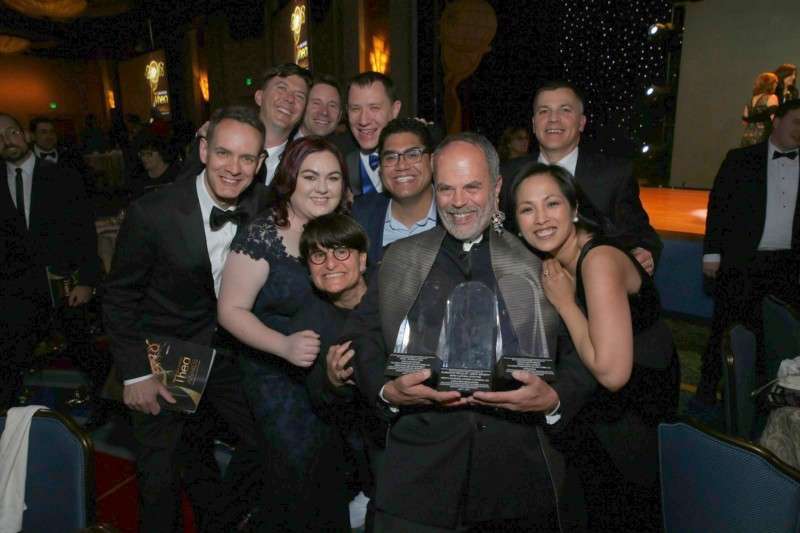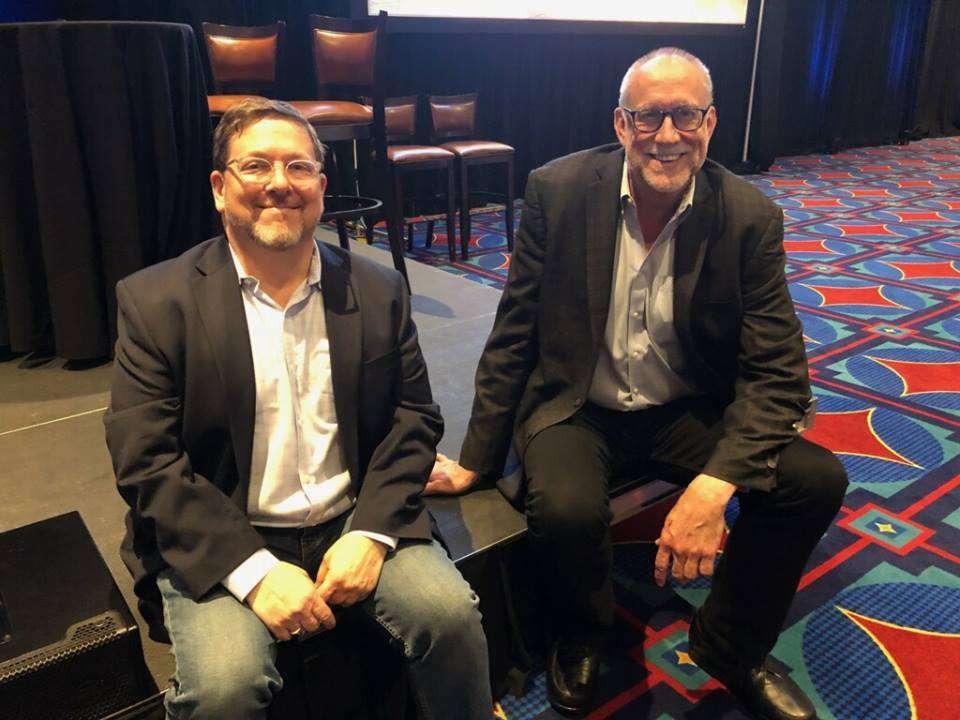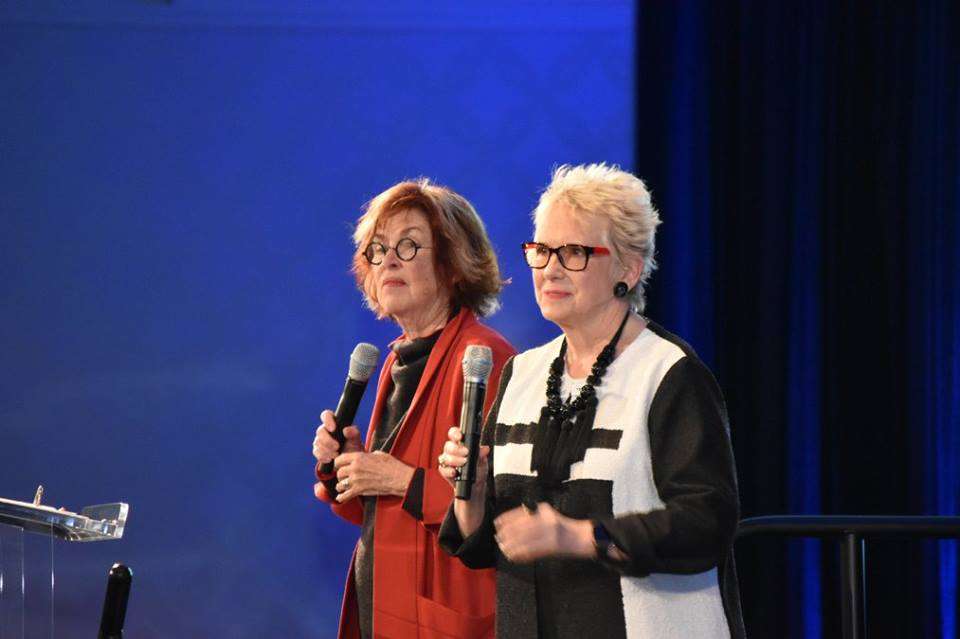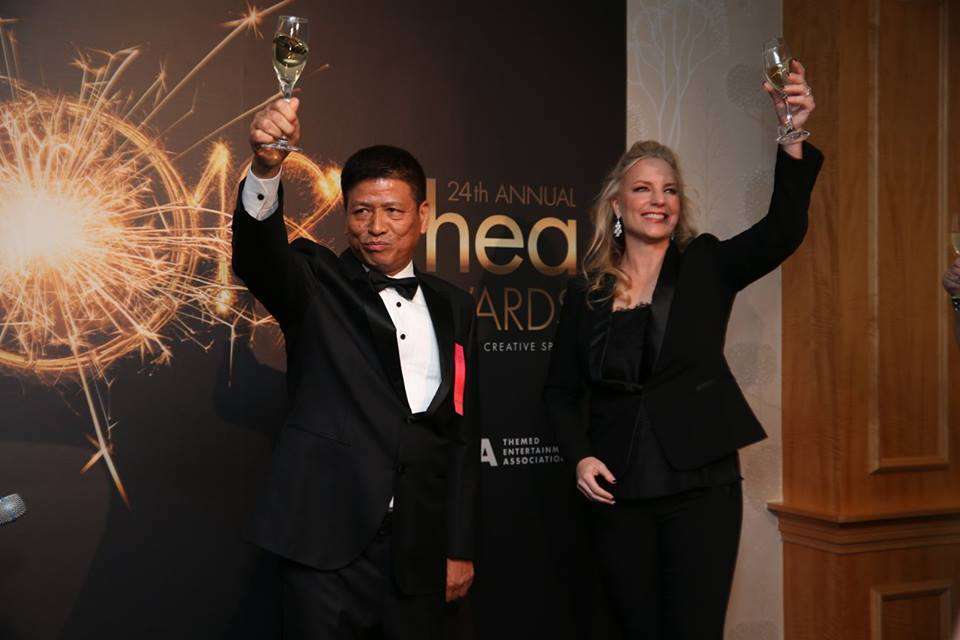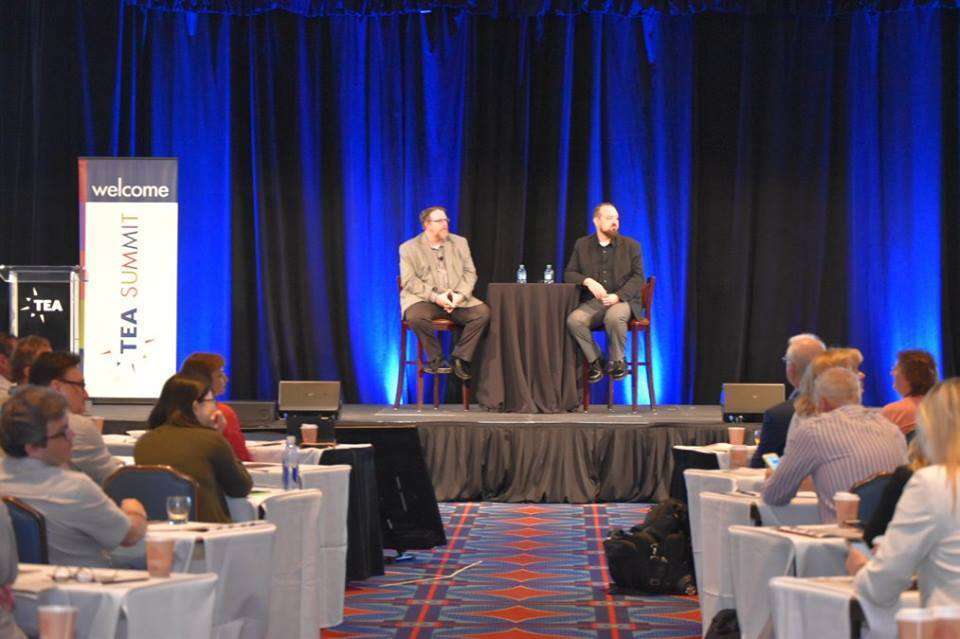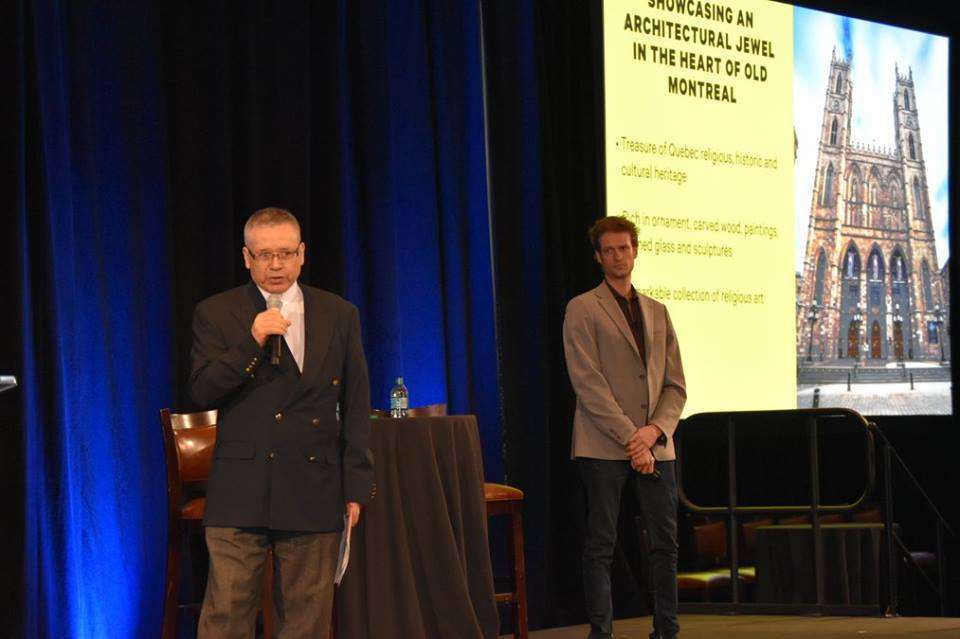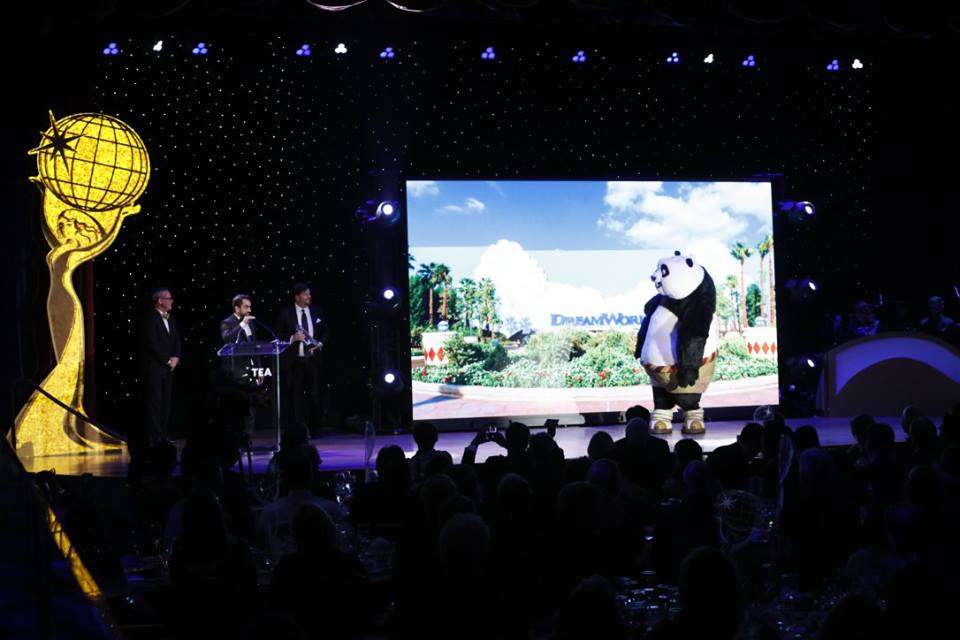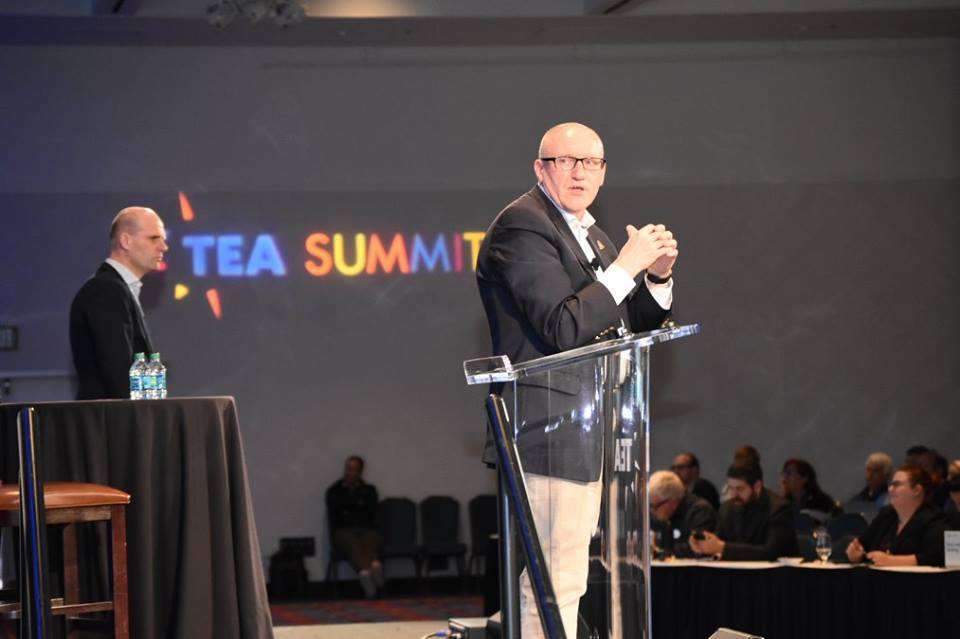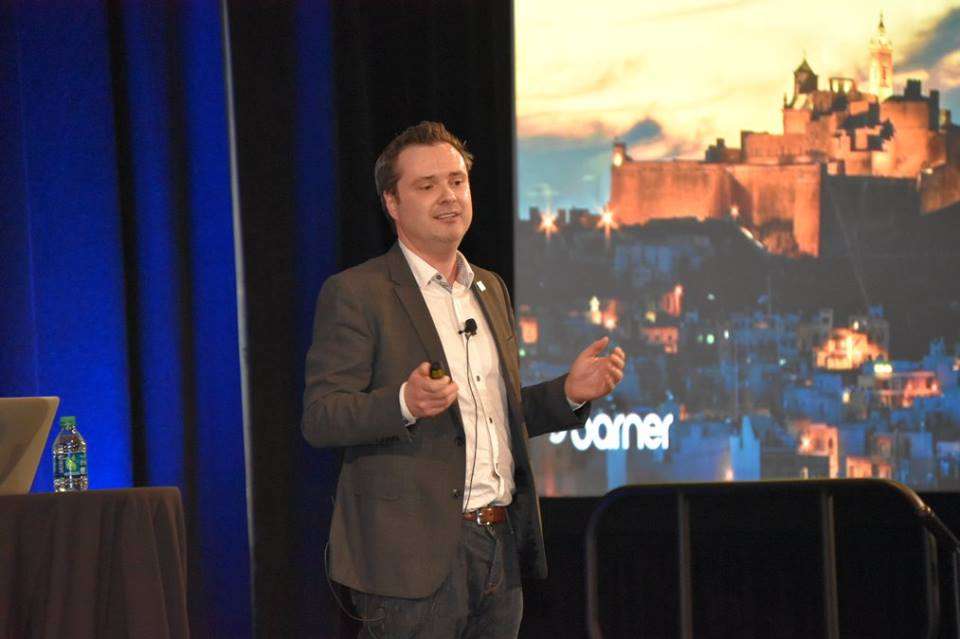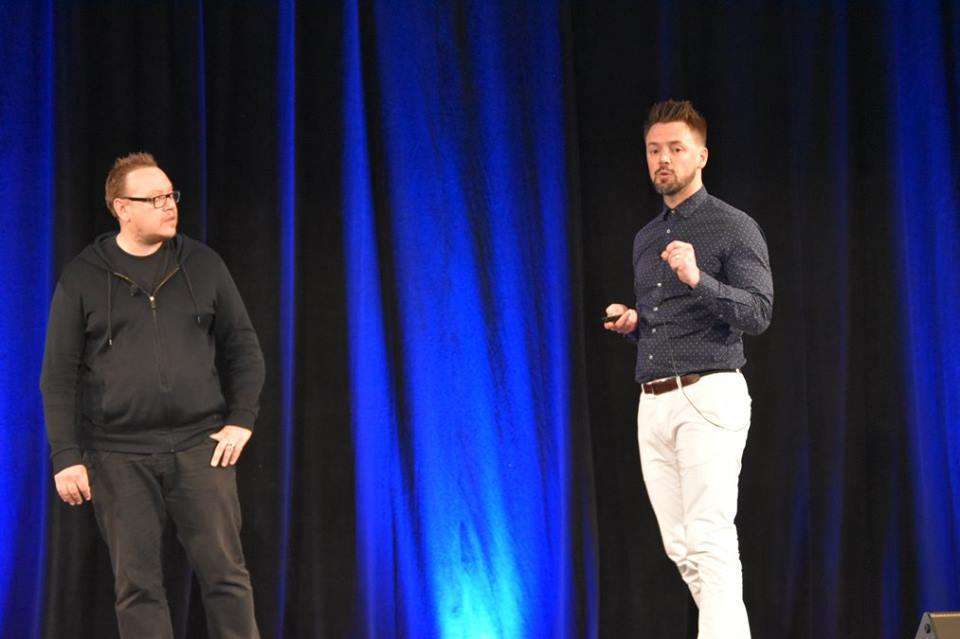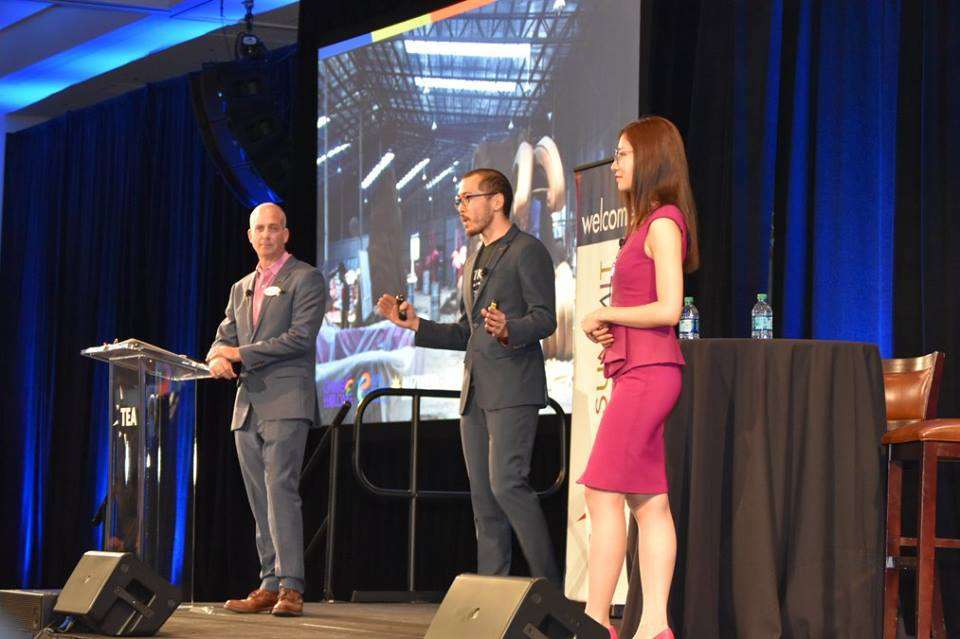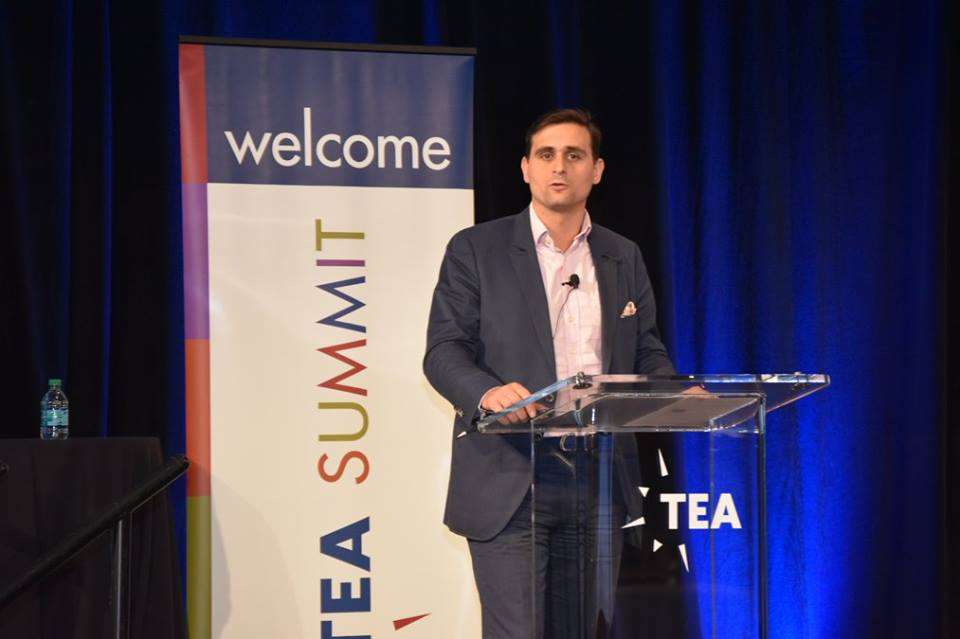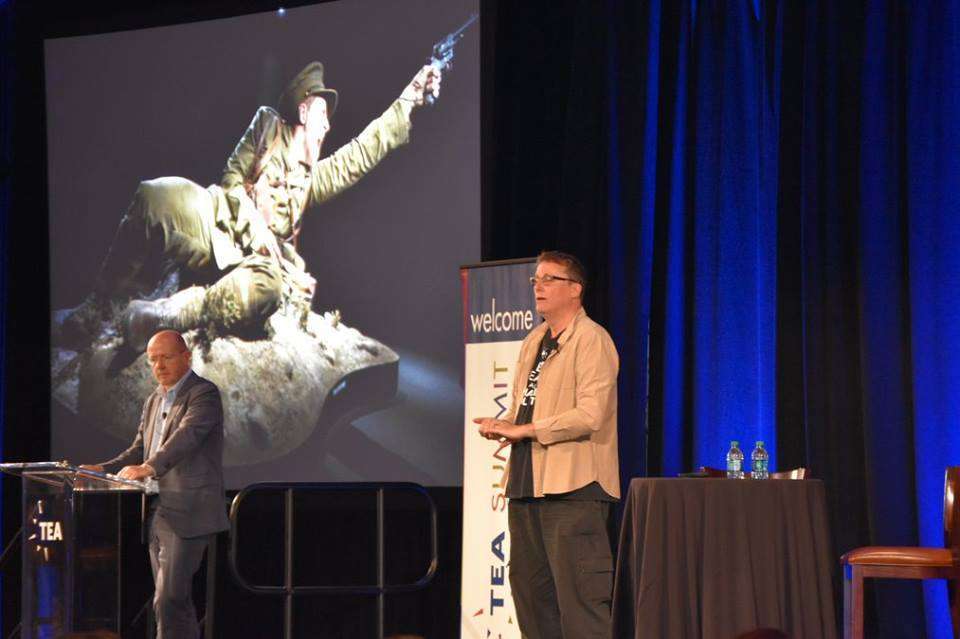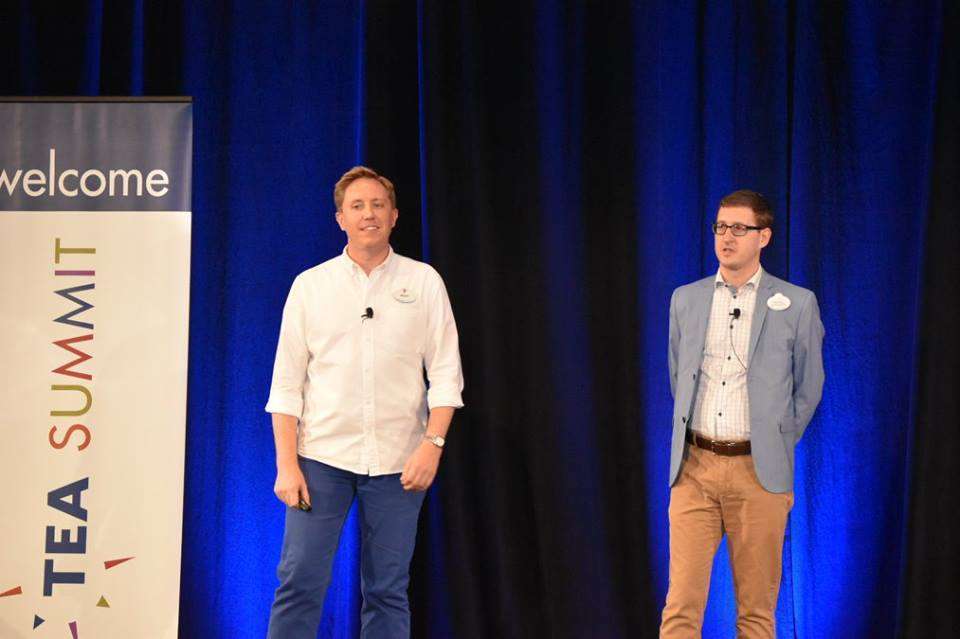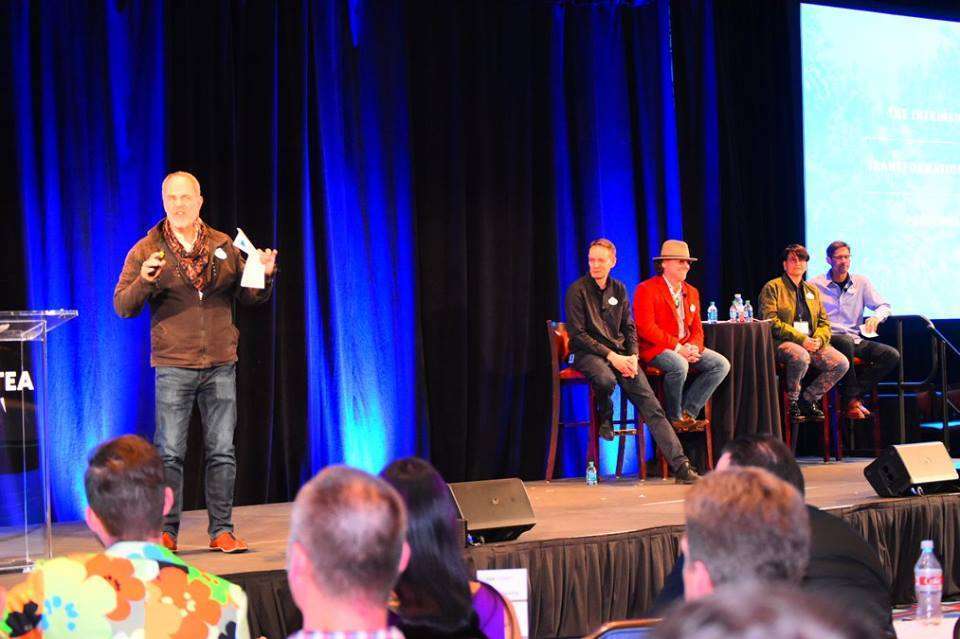At the 2018 TEA Thea Awards Gala, Joe Rohde holds an armful of just-awarded Thea trophies, surrounded by colleagues from Walt Disney Imagineering who worked on the various Disney projects that were honored. All photos courtesy TEA.
Celebrating heritage and culture through themed design
By Joe Kleiman
Each session of the Themed Entertainment Association (TEA) 2018 Thea Case Studies Day on April 6, showcased a project honored the following evening at the annual TEA Thea Awards Gala (April 7), and paid respect to an existing culture – be it a real community or a fictional place.
About the Thea Awards
Adam Bezark (L) and Phil Hettema (R)
Things have grown in the two dozen years since the Thea Awards began in 1994 with a single award, given to the late Harrison “Buzz” Price. Adam Bezark of The Bezark Company, who chaired the 2017-18 Thea Awards Nominating Committee, noted that several hundred submissions were received from which the 2018 slate of 20 recipients was selected.
Once a project has been named for a Thea Award, the project owner must agree to fulfill two expectations: to be present at the Gala to receive the award in person, and to supply a comprehensive credits list. Most recipients also enthusiastically take part in Thea Case Studies Day, which comprises Day Two of the annual, two-day TEA Summit.
Record turnout
Pat MacKay (L) and Roberta Perry (R)
Pat MacKay of Ones&ZerosMedia, who co-chairs Case Studies Day with Roberta Perry of Edwards Technologies, confirmed my impression that the number of people in the room had doubled since I last attended the event two years ago. “This year was our biggest ever with a record 550 people in attendance.” (The Thea Awards Gala that took place the following day also drew a record crowd of more than 800 celebrants, plus some two dozen members of the press.)
Bezark ties the increased interest and growth to the continued globalization of the industry, and ever expanding international awareness. “Around the world, operators, developers and creatives recognize the Thea Award as something highly prestigious that helps put their project on the map.”
Education, celebration and networking
Jennie Nevin with Chimelong Group Chairman Mr. Su Zhigang. Chimelong Group was Presenting Sponsor of the TEA Thea Awards Gala.
Certainly it makes the awards more meaningful for both the recipients and the industry to have case studies that help the themed entertainment world to know itself better: in frank, peer discussion that demystifies what the project process is, how that process unfolded and what kind of impact has resulted.
TEA COO Jennie Nevin explains that TEA is simply fulfilling its mission of serving the creative community that is the basis of its membership, and the owner-operators who make the projects possible, with this pairing of celebratory awards and educational case studies, complemented by the international networking opportunities these events afford. “Our TEA Summit provides a vital forum that includes a special behind-the-scenes, in-depth look at the creative process and storytelling behind the best projects each year,” says Nevin.
And now, the recipients
While most Thea Award recipients are profiled during Case Studies Day (Day Two of the two-day Summit), three were featured during TEA Summit Day One: Phil Hettema, founder of The Hettema Group and recipient of the Buzz Price Thea Award – Recognizing a Lifetime of Distinguished Achievements; Cedar Point, recipient of the Thea Classic Award; and 3D Live, recipient of the Thea Award for Innovative Technology. [Article for all three appeared in InPark Issue #71 – click the links to access.]
Smithsonian National Museum of African American History and Culture (NMAAHC)
Bryan Sieling and Deirdre Cross of NMAAHC accept the museum’s Thea Award during the Thea Awards Gala
African American culture resides not only in the name of this new museum, but within its architecture, collection, and interpretive exhibits. The historic journey starts in the early years of the trans-Atlantic slave trade. When visitors enter the point on the timeline where the United States is founded, the gallery becomes a cavernous 3-story high space. Other galleries celebrate African Americans in the military, sports, and the arts.
In the Reflections booths that are located at various points throughout the museum, visitors can take a private moment to record their thoughts or feelings. In the first year of operation, over 24,000 such video recordings have been made, bridging the gap between the communal and the personal. [See “Tracing the Long Arc of History,” InPark issue 71, https://www.inparkmagazine.com/nmaahc-tracing-the-long-arc-of-history/]
Ghost Town Alive!
Ken Parks (L) and Eric Nix (R) of Knott’s Berry Farm
Before it was a theme park, Walter Knott established a real berry farm in Buena Park, CA. In those days, Knott’s was famous for three things – the boysenberry (it’s said every boysenberry in the world can trace its roots to Knott’s), the chicken restaurant, and Ghost Town, which was founded in 1940 with real buildings from Western desert ghost towns. Seventy-five years later, Cedar Fair has honored the Knotts family by bringing Ghost Town to life in a low-tech, but highly interactive enterprise starring 35 cast members, three musicians, two horses, and a donkey.
The park took a “no promises” approach, eliminating any conflict arising out of advertised activities not happening. During this event, guests can enter Ghost Town’s historic “peek-in” sets and interact with live actors, setting into motion a series of events throughout the day.
Aura
Pastor Miguel Castellanos of Notre-Dame Basilica of Montreal (L) and Jonathan St-Onge of Moment Factory (R)
It’s not every day that a Roman Catholic pastor, in this case Miguel Castellanos of Montreal’s Notre-Dame Basilica, introduces a themed attraction, but Aura showcases the culture of both a religion and a city. Opened in 1829, the Basilica has become one of the city’s most visited sites, with close to 1 million visitors per year. Looking for a new and modern way to showcase the building, its art collection, and unique architecture, the Church mandated Moment Factory to turnkey a multimedia spectacle.
DreamWorks Animation Zone
A Thea Awards Gala moment with Ahmad Hussain bin Essa of DXB Entertainments (at podium), and three stars of DreamWorks Animation – Doug Cooper, Jonathan Linn, and Po the Panda
Within the 43,000 square meter DreamWorks Animation Zone at Motiongate Dubai are four themed areas, each based on a DreamWorks franchise – Shrek, Madagascar, Kung Fu Panda, and How to Train Your Dragon. Each area plays true to the culture of its brand, with its physical elements based on the unique animation design of the films.
Symbolica: The Palace of Fantasy
Coen Bertens (L) and Olaf Vugts (R) of de Efteling
Throughout the years, de Efteling has housed a number of well-known attractions based around fairy tales. In 1986, Fata Morgana, a journey through the world of fairies partially designed by artist Henny Knoet, opened as the park’s first dark ride. Knoet also created the park’s trademark mascot in 1989, Pardoes, an alien jester that comes from the planet Symbolica. To honor Knoet, the park decided to design its newest attraction around Pardoes. Entering the castle that houses Symbolica, a stairway suddenly splits into two, welcoming guests to the corridors beneath the castle. Once there, they board trackless vehicles for one of three rides, themed to treasure, heroes, or music.
Cittadella Visitors Centre
Michael Bennett of Sarner International)
At a strategic vantage point on Gozo, a sister island to Malta, sits the Cittadella, which traces its roots back to Roman times. Sarner International won an EU tender to design the exhibition.
Built in a space formerly occupied by the Cittadella’s underground reservoirs, the center of the Visitors Centre features a trompe-l’œil depiction of the interior of the Cathedral of the Ascension’s dome. Surrounding it are interactive information stations. Visitors are summoned down a hallway by the projected image of Calypso to a theater in a 10m x 10m space (complete with central support column) where eight historic five-meter-high arches act as screens, providing a 360-degree history of the Cittadella.
Jameson Distillery Bow St.
Christian Lachel of BRC Imagination Arts (L) and John Carroll of Irish Distillers Pernod Ricard (R)
Whiskey is a cultural icon of Ireland. And Jameson is a cultural icon in the whiskey world. For a brand like Jameson, which is now pursuing brand loyalty and advocacy, a brand home can make a huge difference, as visitors tend to spend two or more hours in a physical environment. Jameson’s visitor center opened on Dublin’s Bow Street in 1997. A decade later, it underwent a small renovation. As John Carroll, Project Director for Irish Distillers, pointed out, “Another decade has now passed, and it’s time for another cyclical refurbishment.”
BRC designed five key experiences: the distillery tour, whisky blending class, cocktail making class, tasting experience, and cask draw experience, each designed as an intimate multi-sensory experience, staying true to the culture of the brand.
Journey of Lights Parade
(L to R): Ryan Miziker and Sean Chung of Miziker Entertainment with Charlotte He of Chimelong Group
For its first permanent nighttime parade, Chimelong hired Miziker Entertainment to create a show where all the lights on all the floats and costumes were interconnected. The eight parade units are themed to Chimelong’s own IP characters, animals found in the park, the circus (a staple of the Zhuhai resort), and pirates and mermaids. At certain points during the parade, all the lights on every unit synch up together. This is accomplished through a pioneering application of individually programmable LED lights.
Project war story: Miziker’s Sean Chung related the discovery that the Chinese fabricator had already begun constructing the floats prior to full approval and using older specs, resulting in the fabrication being unable to fit lights. The solution was a special metal rigging devised by Miziker to fit on the inside of the float structure, giving it the needed shape – and attaching fixtures with zip ties.
Rainis’ Museum
Holgers Elers of H2E Design Studio and Sanita Kossoviča. of the Association of Memorial Museums, Latvia show one of the wooden balls central to the Rainis’ Museum’s exhibits
Rainis was a poet, playwright, and politician whose philosophy played a key role in the establishment of Latvia. Located in Tadenava, his birthplace, the museum welcomes more than 3,000 visitors annually to the small town. The project is very low tech. Throughout the museum a wooden ball is used as a central theme, continuing a narrative through several tasks. Mechanisms throughout the museum featuring the words of Rainis, bring his philosophy into the physical world through the interactive tasks at hand. Exhibit designer Holgers Elers of H2E Design Studio explained, “If we don’t lose the ability to be open to the world, then the world is open to us and everything has meaning.”
Les Carrières de Lumières
Augustin de Cointet de Fillain of Culturespaces
Culturespaces is a private firm that manages a number of leading historical sites, museums, and exhibits throughout France. One of its properties is the Castle of Les Baux de Provence, a 10th Century castle in the south of France. Nearby are the Les Grands Fonds, an underground limestone quarry that operated in the 19th Century and closed in 1935.
In 2012, the city of Baux de Provence granted management of the quarry to Culturespaces, which renamed it Les Carrieres de Lumieres. With no voiceover or written narration, visitors are invited to experience classic works of art in a new dynamic way. Ninety-seven projectors, illuminating over two million pixels, bring historic paintings to life with dynamic animation on the walls, floor, and ceiling of the quarry, creating a complete 360 degree experience. Culturespaces has added a second location in Paris.
Gallipoli: The scale of our war
Ian Crowe of Museum of New Zealand Te Papa Tongarewa (L) and Sir Richard Taylor of Weta Workshop (R)
There are 4.8 million people in the nation of New Zealand. Te Papa, the national museum, has estimated that half of them have gone through its Gallipoli exhibition. The exhibit tells the tales of New Zealanders who participated in the famous WWI battle, in which 2,779 New Zealanders lost their lives. To tell the story with pathos, it was decided to concentrate on individuals, rather than on the Army as a whole.
Weta Workshop sculpted eight individuals that would each tell a different aspect of the war, each at 2.4 times human size. Their stories are real and are based on diaries. Realism of the sculptures was of upmost importance. Body parts, including eyeballs, were 3D printed, then painted by hand. The key to the success of the exhibit was the very personal connection with the visitors facilitated by the hyper-real style of presentation.
Frozen Ever After
Wyatt Winter (L) and Michel den Dulk (R) of Walt Disney Imagineering
Frozen Ever After was a retrofit of the Norway pavilion’s Maelstrom boat ride in Epcot (Walt Disney World) that stays true to Norwegian architecture and culture, as does the Royal Sommerhus meet and greet area, which doubled the pavilion’s size. The ride now tells a follow-up story to the FROZEN film. By reconfiguring the load and unload areas and transforming a former cinema space into additional queue, the Imagineers were able to add an additional minute to the ride time. An audio animatronic Elsa is there, belting “Let It Go.”
Guardians of the Galaxy – Mission: BREAKOUT!
(L to R): Walt Disney Imagineering’s Joe Rohde, Claire Weiss, and John Mauro
The Thea Case Studies audience was fortunate in that all the Disney presentations included participation from the legendary Joe Rohde, a WDI creative executive whose trademark flow of words and ideas is always compelling, punctuated by such apt observations as, “There’s only so much you can do with a vehicle that just goes up and down.” To create a new kind of experience, the GOTG attraction vehicle – which was part of a full re-imagining of the former attraction Tower of Terror, inside and out – switched from using a downward thrust, which promotes fear, to an upward one, which supports exhilaration, shooting directly up from the loading station.
The challenge with Guardians of the Galaxy – Mission: Breakout! was to remain true to the culture of the Marvel films (which have a subversive tone, so it was important to maintain that feel throughout) while retrofitting an existing structure with a new blockbuster attraction – while the team’s deadline was approaching at warp speed, in only a few months. This was achieved by democratizing the design process and allowing the staff to take charge of a project without going a multi-tiered approval process. The mantra for this project was: “If it’s not wrong, it’s the right decision.”
Pandora – The World of Avatar
(L to R): The Walt Disney Imagineering leads behind Pandora – The World of Avatar and Avatar Flight of Passage — Joe Rohde, Mark LaVine, Zsolt Hormay, Amy Jupiter, and Edward B. Fritz
To fit a science fiction story into an animal park, Disney Imagineers worked to maintain three key aspects of Animal Kingdom within Pandora – it must be about animals, it must showcase natural landscapes over man-made objects, and the story is rooted to the land. In Animal Kingdom, the story is about the dimensional world, rather than about specific characters or a linear plot.
To accomplish this, the Imagineers created a version of the planet Pandora set decades after the events in Jim Cameron’s “Avatar” films. The military and mining company are gone, though their relics remain, and the planet is now welcoming visitors on eco-tourism tours.
Plants and structures were built by Disney’s Themed Finishes Art Studio, using a combination of modern and time-honored techniques, such as murals, color boards, and blacklight paint. There are no big marquee signs in the land, rather totems establishing the entrance to attractions.
Avatar Flight of Passage
Avatar Flight of Passage, like the rest of Pandora, plays tribute to the mythology of the film series, while also honoring the park’s conservation message, in a way that offers multiple opportunities for self-engagement.
Pandora is far from perfect, carrying forth the park’s conservation message by openly conveying how humans can damage an ecosystem. Rohde refers to the queue of the land’s signature attraction, Avatar Flight of Passage, as “one big superfund cleanup site.” As guests wind through the queue, they encounter smaller and smaller spaces, traveling through a ritualistic cave of the indigenous Na’vi, the remnants of a mining operation, and a research laboratory.
The ride itself is the next generation of flying attraction. Guests sit in linked chairs, wearing 3D glasses, and listening to directional sound. A bladder on the chair simulates the breathing of the flying banshee they ride on, while every 60 frames, motion, music, focus, sound, and specific points on the film are highlighted to continually engage them.


